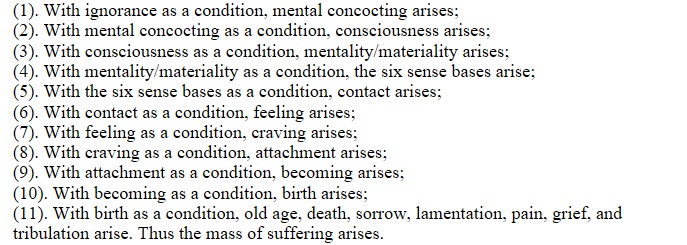
Paticcasamuppada is a key law in Buddhism yet it seems so complex. Dharma Dan focusses on phassa - contact, and Buddhadasa speaks of contact and ignorance. This key law takes on a completely more sympathetic position if we think of neural pathways. Here is an oversimplification of the law:-
 Ignorance Ignorance
 Ignorant neural pathway Ignorant neural pathway
 Contact Contact
 Clinging neural pathway Clinging neural pathway
 Suffering Suffering
Let’s start with Dharma Dan and his contact. An event happens, our attention registers the event and then lets it go - no suffering. But suppose we have some bad habitual actions - clinging - associated with a particular event. DD talks of our being aware of contact and therefore clinging, and special attention to contact avoids clinging. This could be understood in terms of neural pathways. Once we let the contact slip into the clinging neural pathway, we have that clinging; let mindfulness hold the contact, evaluate and let go - no clinging. Neural pathways help us by allowing us to complete an action such as swimming without the need for meticulous consciousness concerning the different phases of swimming. Similarly neural pathways turn contact into clinging. Hence we focus on how we handle the contact by not allowing the neural pathway to kick in so that clinging doesn’t happen. So we could assess steps 6 through 11 as a clinging neural pathway And we concentrate on not allowing phassa - contact - to become a condition. So we use our mindfulness - grace - Dhamma consciousness - to ensure that the event does not become suffering.
It is easy to see that a contact unmindfully could trigger steps 6 to 11 by triggering a typical neural pathway. For zandtao, a neural pathway is a pathway of the brain that once triggered leads to a sequence of habitual actions. It is reasonable to think that a contact could trigger a neural pathway causing suffering. And it is therefore an especially good practice to be mindful of new contacts as they can trigger a neural pathway to suffering.
The brain creates neural pathways to facilitate thoughts becoming action. In this case it is the neural pathway of clinging that has built up through upbringing and life’s conditioning - what would typically be called habit or routine. Recognising the routine of this neural pathway gives us a strategy for avoiding clinging - work with the neural pathway but be mindful at phassa.
Through mindfulness and thought we could fashion a new neural pathway that might help avoid clinging but this neural pathway has happened because it is natural - following the law of paticcasamuppada. We don’t want clinging but we have a strategy - work with the neural pathway but be mindful at phassa.
Buddhadasa has also spoken of ignorance as leading to suffering through paticcasamuppada. Let’s see what happens with ignorance. Wisdom leads to atammayata - creating a state of mind that avoids conditioning. Zandtao can see this avoidance arising through the application of wisdom - a grace or Dhamma comrade. Through wisdom we can develop right knowledge, knowledge that will help us live a good life. With “wrong knowledge” can arise thoughts through the ignorance neural pathway that can lead to kilesa, upadana or attachment to khandha, these are the thoughts or events that mindfulness deals with at phassa. Right knowledge will not engage these thoughts. If we know kilesa, conditions for the 4 upadanas and attachment to khandhas give rise to suffering, then we know to avoid situations that give rise to these. If we know that going to a girlie show gives rise to lust we don’t go, if we know that going to a casino gives rise to greed and gambling we don’t go; it is far harder to control lust if we are at a girlie show or to control greed if we are in a casino so we use right knowledge to live a better life. We must learn what attachments our khandhas are likely to give rise to, what kilesas we are most susceptible to, what clingings we grasp, and we avoid situations where such attachments could happen. And if there are situations that cannot be avoided we are aware of what could lead to attachment and we use our mindfulness to protect ourselves.
A bit Buddhist this reflection but it arose from Teal’s use of the term neural pathway in “How to Love Yourself” that gave zandtao some clarity on what is mind and brain, and how mind uses brain.
|


